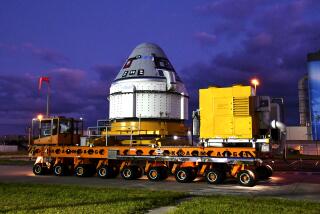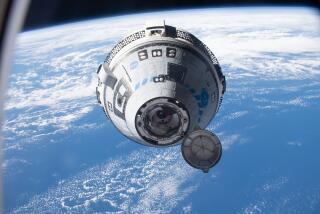FLIGHT OF THE SHUTTLE DISCOVERY : Rigid ‘Windows’ to Keep Launches on Tight Schedule
- Share via
KENNEDY SPACE CENTER, Fla. — NASA’s launch schedule for the next couple of years leaves little room for slippage because it is dominated by missions that can only be launched at certain times if their goals are to be achieved.
The top priority, according to the space agency, will be to maintain a schedule that will allow three important solar system probes to be launched from the shuttle during crucial “windows” over the next two years. The loser in the frantic behind-the-scenes maneuvering for space aboard the shuttle has been the Hubble Space Telescope, the cornerstone of a series of orbiting observatories planned by the National Aeronautics and Space Administration.
Delayed Until Early 1990
The telescope has been delayed until February of 1990, and that means it will reach orbit nearly four years later than originally planned.
The $1.2-billion telescope, which was to have been launched in May of 1986, will be the most powerful telescope in space. The long delay in its deployment has been agonizing to the scores of scientists who have already given it a considerable portion of their careers. It is expected to open dramatic new windows on the universe.
For the scientists at the Jet Propulsion Laboratory near Pasadena, the launch schedule looks far more encouraging than many of them had expected in the long months after the Challenger explosion. Two key planetary probes--one to map the surface of Venus and another to study Jupiter and its moons--have been given the highest priority, according to NASA officials.
Both are to be launched in 1989.
In October of 1990--four years late--NASA plans to finally launch the Ulysses spacecraft for the European Space Agency. The joint NASA-ESA project will study the sun.
NASA also managed to come up with a mission that would bring something back from space, and just in time. The Long Duration Exposure Facility, an orbiting satellite about the size of a school bus, was to have been retrieved a couple of years ago.
Recognizing that the huge research satellite could tumble from orbit and crash to Earth as early as 1990, NASA will try to pluck it from orbit in November of 1989 with the shuttle Columbia and return it safely to the ground. The satellite has been collecting data on the long-term exposure of certain materials to the effects of space, including radiation.
Schedule of Launches
Here is the current schedule for shuttle launches through next year, and some of the key objectives:
Nov. 17, 1988--Atlantis, Department of Defense, classified mission.
Feb. 18, 1989--Discovery, launch of a tracking and data relay satellite for NASA.
April 29, 1989--Atlantis, launch of Magellan to Venus.
July 1, 1989--Columbia, classified defense mission.
Aug. 10, 1989--Discovery, classified defense mission.
Oct. 12, 1989--Atlantis, launch of Galileo to Jupiter.
Nov. 13, 1989--Columbia, deploy one communications satellite and rescue the Long Duration Exposure Facility.
Dec. 11, 1989--Discovery, classified defense mission.






